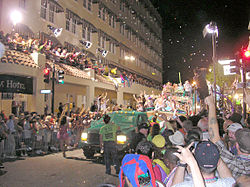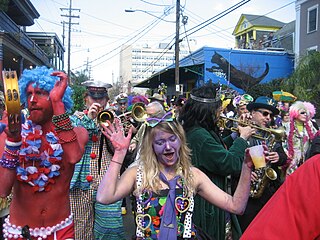This article needs additional citations for verification .(November 2016) |

Fantasy Fest is a street party held annually in the last week of October in Key West, Florida.
This article needs additional citations for verification .(November 2016) |

Fantasy Fest is a street party held annually in the last week of October in Key West, Florida.
| Part of a series on the |
| History of Key West |
|---|
 |
Fantasy Fest was initiated in 1979 by Bill Conkle, Tony Falcone, Joe Liszka and Frank Romano to attract tourists during the slow season. [1] [2] In 1995 over 60,000 people attended and there were 70 floats, bands, costumed groups and "imprecision drill teams" in the parade. [3] In 2001 Fantasy Fest was estimated to bring $35 million to the region each year. [4] [ non-primary source needed ]
The highlight of Fantasy Fest is its parade featuring humorous floats, including one carrying the annually elected Conch King and Queen. The floats can be quite elaborate; costs can be $10,000 to $15,000. [5] The expense for the floats is borne fully by the participant groups (called krewes) and their sponsors. [1] [5]
In October 2005, the event was postponed because of devastation wrought on the island by Hurricane Wilma; instead of being held at its usual time close to Halloween, it was moved to December and celebrated just before Christmas. [6] The theme that year was "Freaks, Geeks and Goddesses."
2020 was to be in its 42nd year. However, that year's event was cancelled due to the COVID-19 pandemic and deferred to 2021.

Fantasy Fest has been compared to New Orleans Mardi Gras and Carnival in Rio de Janeiro. [1] As with New Orleans Mardi Gras on Bourbon Street in New Orleans, Fantasy Fest tend to attract many people to the concentration of bars along Duval Street. Most of the event is adult oriented, however, there are family friendly events. [7] Nudity is illegal in Key West, but on the last two days of Fantasy Fest the city designates a "Fantasy Zone" in the city where women may expose their breasts if they are covered with body paint. [8] Costumes worn at Fantasy Fest often feature nudity and sexual symbolism. [1]

The King and Queen of Fantasy Fest are annual titles bestowed at the Coronation Ball, a fundraiser for a community AIDS care service, that marks the official beginning of the event. [1] The king and queen are residents of Key West, Florida, selected via an 8-week fundraising campaign.
Their Royal Court is subsequently composed of fellow Candidates who didn't raise as much, but are still honored with the titles of Duke and Duchess (and, one rare instance, Prince and Princess).[ citation needed ] For 8 weeks, these Candidates serve as ambassadors for AIDS Help, the non-profit agency that has assisted those living with HIV/AIDS in the Keys since 1986.
A wildly-varied array of events are individually staged by Candidates, as well as All-Candidate events that unite the campaigns, including a spin on the 'America Idol' singing competition, a randy and raucous Sunday BINGO, a Saturday Red Shirt Run in September and mixers at familiar island venues.
The Royal Court, their support staff and other key agency supporters all appear prominently in the evening Duval Street parade on a float designed specifically to highlight their financial achievement.

Mardi Gras is the final day of Carnival ; it thus falls on the day before the beginning of Lent on Ash Wednesday. Mardi Gras is French for "Fat Tuesday", reflecting the practice of the last night of consuming rich, fatty foods in preparation for the Christian fasting season of Lent, during which the consumption of such foods is avoided.

A krewe is a social organization that stages parades and/or balls for the Carnival season. The term is best known for its association with Mardi Gras celebrations in New Orleans, but is also used in other Carnival celebrations throughout Louisiana and along the Gulf of Mexico, such as the Gasparilla Pirate Festival in Tampa, Florida, Springtime Tallahassee, and Krewe of Amalee in DeLand, Florida with the Mardi Gras on Mainstreet Parade as well as in La Crosse, Wisconsin and at the Saint Paul Winter Carnival.

The Sydney Gay and Lesbian Mardi Gras or Sydney Mardi Gras is an event in Sydney, New South Wales attended by hundreds of thousands of people from around Australia and overseas. One of the largest LGBT festivals in the world, Mardi Gras is the largest Pride event in Oceania. It includes a variety of events such as the Sydney Mardi Gras Parade and Party, Bondi Beach Drag Races, Harbour Party, the academic discussion panel Queer Thinking, Mardi Gras Film Festival, as well as Fair Day, which attracts 70,000 people to Victoria Park, Sydney.

The Mistick Krewe of Comus (MKC), founded in 1856, is the oldest extant New Orleans, Louisiana Carnival Krewe, the longest to continually parade with few interruptions from 1856 to 1991, and continues to hold a tableau ball for its members and guests, to date. Initially its public facade was The Pickwick Club.

The Rex Organization, commonly referred to simply as Rex, is a New Orleans Carnival krewe which stages one of the city's most celebrated parades on Mardi Gras Day. Rex is Latin for 'king', and Rex reigns as "The King of Carnival".

The holiday of Mardi Gras is celebrated in southern Louisiana, including the city of New Orleans. Celebrations are concentrated for about two weeks before and through Shrove Tuesday, the day before Ash Wednesday. Mardi Gras is French for Fat Tuesday, the season is known as Carnival and begins on 12th Night, January 6th, and extends until midnight before Ash Wednesday. Club, or Krewe, balls start soon after, though most are extremely private, with their Kings and Queens coming from wealthy old families and their courts consisting of the season's debutantes. Most of the high society Krewes do not stage parades. As Fat Tuesday gets nearer, the parades start in earnest. Usually there is one major parade each day ; many days have several large parades. The largest and most elaborate parades take place the last five days of the Mardi Gras season. In the final week, many events occur throughout New Orleans and surrounding communities, including parades and balls.
The Krewe of OAK is a small neighborhood New Orleans Mardi Gras krewe and parade held in the Carrollton neighborhood of New Orleans, Louisiana. The parade starts and ends on Oak Street, presumably the origin of the name, although members say that OAK stands for "Outrageous And Kinky".

"La Société de Saint Anne" is a New Orleans Mardi Gras marching krewe that parades each Mardi Gras Day. La Société de Saint Anne was founded in 1969 by residents of the French Quarter and nearby Faubourgs who recognized the need for a return to earlier traditions of "walking krewes" which at one time were more prevalent but which had been overshadowed by the development of larger float parades in the early 20th Century. As the float parades grew in scale and number, they were forced to move out of the narrow streets of the French Quarter and onto broader avenues uptown and in mid-City. The walking krewes were groups of neighbors from various wards of the city who took to the streets on foot, in celebration of their common love for the City of New Orleans and the food, music, drink, spirituality, and lifestyles that developed there during the 18th, 19th & 20th centuries. La Société de Saint Anne was formed to bring the celebration back down to street level and to revive this old tradition of celebration in the residents' own area. In the ensuing years, as the more bohemian elements of the French Quarter were forced to move further downriver to the Marigny and Bywater neighborhoods by rising property values and rents in the French Quarter, the krewe grew in size and inspired many other such walking krewes to form as subkrewes or as separate krewes altogether. The original krewe now can be identified by the cluster of crabnets and the presence of the Storyville Stompers.
Carnival Memphis is a series of parties and festivals staged annually since 1931 in Memphis, Tennessee, by the centralized Carnival Memphis Association and its member krewes during the month of June. Carnival salutes various aspects of Memphis and its industries, and is reigned over by current year's secretly selected King, Queen, and Royal Court of Carnival.
Krewe of Tucks is a New Orleans Mardi Gras krewe.
KOE, formally known as the Krewe of Elvis, is a Mardi Gras parading organization that consists of members from around the world who meet in New Orleans for Mardi Gras.
The Mystic Krewe of Barkus is a New Orleans Mardi Gras parade where participants are dogs costumed according to a central parade theme. The annual event is organized by the Krewe of Barkus, a nonprofit organization that promotes adoption and rescue of homeless animals in New Orleans. The Mystic Krewe of Barkus makes fun of the more traditional New Orleans Mardi Gras parades and is the only Mardi Gras "krewe" in New Orleans created for dogs.

Mardi Gras is the annual Carnival celebration in Mobile, Alabama. It is the oldest official Carnival celebration in the United States, started by Frenchman Nicholas Langlois in 1703 when Mobile was the capital of Louisiana. Although today New Orleans and South Louisiana celebrations are much more widely known for all the current traditions such as masked balls, parades, floats and throws were first created there. From Mobile being the first capital of French Louisiana (1702), the festival began as a French Catholic tradition. Mardi Gras has now evolved into a mainstream multi-week celebration across the spectrum of cultures, becoming school holidays for the final Monday and Tuesday, regardless of religious affiliation.

A mystic society is a Mardi Gras social organization in Mobile, Alabama, that presents parades and/or balls for the enjoyment of its members, guests, and the public. The New Orleans Krewe is patterned after Mobile's Mystics. The societies have been based in class, economic and racial groups. Mobile's parading mystic societies build colorful Carnival floats and create costumes around each year's themes.

Mardi Gras in the United States is celebrated in a number of cities and regions in the country. Most of these places trace their Mardi Gras celebrations to French, Spanish, and other Catholic colonial influences on the settlements over their history.

The Intergalactic Krewe of Chewbacchus is a science fiction–themed Mardi Gras krewe, religious and parade organization, that also features fantasy and horror groups, among other fandoms. Based in New Orleans, Louisiana, as of the 2019 parade, the Intergalactic Krewe of Chewbacchus has over 2500 dues-paying members who call themselves "ChewbacchanALIENs" or "Chewbs."
Bahamian cuisine refers to the foods and beverages of The Bahamas. It includes seafood such as fish, shellfish, lobster, crab, and conch, as well as tropical fruits, rice, peas, pigeon peas, and pork. Popular seasonings commonly used in dishes include chilies, lime, tomatoes, onions, garlic, allspice, ginger, cinnamon, rum, and coconut. Rum-based beverages are popular on the islands. Since the Bahamas consist of a multitude of islands, notable culinary variations exist.

The Krewe of Cleopatra is a New Orleans Mardi Gras Super Krewes and social organization.
Krewe of Okeanos is a New Orleans Mardi Gras krewe.
Henri Schindler is an American Mardi Gras historian and float designer.
{{cite AV media}}: CS1 maint: others in cite AV media (notes) (link)